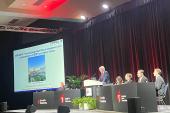Analysis Cements Benefits of SGLT2 Inhibitors in HF, but Diabetes Matters for Deaths
HF hospitalizations were reduced in all patients, yet only the higher-risk diabetic patients gained the survival advantage.

A new meta-analysis of more than a dozen clinical trials confirms the clinical benefit of sodium glucose cotransporter 2 (SGLT2) inhibitors for patients with heart failure (HF).
The pooled data from 13 clinical trials and more than 75,000 patients, including the EMPEROR-Preserved trial in preserved ejection fraction, show that the drug class reduced the risk of HF hospitalization in patients with and without diabetes, as well as reduced the risk of cardiovascular mortality in patients with diabetes. In HF patients without diabetes, there was a trend toward fewer deaths from cardiovascular causes, but the results were not statistically significant, report investigators.
“If you looked to almost all [randomized controlled trials] evaluating safety and efficacy of SGLT2 inhibitors—either in those early cardiovascular safety trials in patients with diabetes mellitus but without heart failure or in RCTs of heart failure patients with or without diabetes mellitus—you will find an astonishingly consistent signal for reduction of incident heart failure hospitalization with similar relative risk reduction in the range of 27% in some trials, to 35% in others,” senior investigator Ahmed Bendary, MD (Benha University, Egypt), told TCTMD.
The results of the meta-analysis, he added, confirm benefits seen in the RCTs, with relative reductions in risk in line with those trials.
With respect to mortality, the analysis may have been underpowered for cardiovascular death in patients without diabetes, due to the small number trials reporting this outcome separately in a nondiabetic population, said Bendary. Still, across the RCTs for all SGLT2 inhibitors, there was no evidence of a significant interaction for the composite primary outcome based on the glycemic status.
“But when you start looking specifically to the endpoint of CV death, some heterogenous treatment effect based on the glycemic status emerges, albeit with statistical caveats,” he said.
‘Crystal-Clear Class Effect’
The meta-analysis, which was published online ahead the January 2023 print issue of the American Journal of Cardiology, included studies that compared the SGLT2 inhibitors—empagliflozin (Jardiance; Boehringer Ingelheim/Eli Lilly), dapagliflozin (Farxiga; AstraZeneca), canagliflozin (Invokana; Janssen), ertugliflozin (Steglatro; Merck Sharp & Dohme), and sotagliflozin (Zynquista; Sanofi Aventis/Lexicon)—against placebo in HF patients with and without diabetes.
The meta-analysis included such trials as CANVAS, DECLARE-TIMI, DAPA-HF, EMPA-REG OUTCOME, EMPEROR-Reduced, EMPEROR-Preserved, SCORED, SOLOIST-WHF, and VERTIS. Other smaller studies, including EMPATROPISM, DEFINE-HF, and EMPIRE HF Renal, were also part of the analysis.
In HF patients with and without diabetes, use of the SGLT2 inhibitors reduced heart failure hospitalizations by 32% and 25%, both of which were statistically significant. With respect to cardiovascular mortality, SGLT2 inhibition reduced the risk by 13% in HF patients with diabetes. In the nondiabetic population, however, there was no significant effect on cardiovascular mortality (RR 0.93; 95% CI 0.70-1.23). Overall, there was a significant 38% reduction in the risk of urgent HF visits (P < 0.00001), but the pooled analysis showed no significant effect of SGLT2 inhibition on the risk of MI or stroke.
The drugs were also safe when compared with placebo, with the analysis showing the SGLT2 inhibitors were associated with a lower risk of serious adverse events in HF patients with diabetes and a trend toward less risk in those without diabetes. There was no difference in the risk of drug discontinuation because of adverse events between placebo and SGLT2 inhibition.
“We can say that the findings of this meta-analysis, among others, are undoubtedly setting the stage for a crystal-clear class effect of SGLT2 inhibitors on safe and effective improvement of heart failure outcomes across the ejection fraction and the glycemic spectrum,” said Bendary. “This is a new chapter in heart failure therapeutic armamentarium.”
Many New HF Drugs Available
Carlos Santos-Gallego, MD, PhD (Icahn School of Medicine at Mount Sinai, New York), who led the EMPATROPISM study, said the new meta-analysis is the most complete to date, with the largest number of patients. While the results aren’t novel given data from the randomized trials, “it confirms the efficacy and safety of SGLT2 inhibitors in patients with heart failure, both with and without diabetes,” he observed.
One trial that’s not included in the meta-analysis is EMPULSE, Santo-Gallego said, noting that this trial showed a benefit of starting SGLT2 inhibition with empagliflozin in patients hospitalized with acute decompensated HF. The benefit of starting SGLT2 inhibition further upstream—either in the hospital or within 3 days of discharge—also was demonstrated in SOLOIST-WHF, he said.
Like Bendary, Santos-Gallego said the observed reductions in HF hospitalizations in patients with and without diabetes are comparable to those seen in the large trials. While the HF and renal benefits are clear, the effect of SGLT2 inhibition on cardiovascular mortality is still somewhat controversial, he said. Some trials have demonstrated a reduction in deaths, such as EMPA-REG OUTCOME and DAPA-HF, but others, including EMPEROR-Preserved, have not.
We can say that the findings of this meta-analysis, among others, are undoubtedly setting the stage for a crystal-clear class effect of SGLT2 inhibitors on safe and effective improvement of heart failure outcomes across the ejection fraction and the glycemic spectrum. Ahmed Bendary
“One of the nice things they do in the meta-analysis is that they are pooling trials together and are able show a reduction in cardiovascular mortality in patients with diabetes,” said Santos-Gallego. Although there was no reduction in deaths in the nondiabetic patients, he stressed that reducing HF hospitalizations and improving quality of life is of paramount importance to patients.
The SGLT2 inhibitors “have been paradigm changing, an absolute revolution,” said Santos-Gallego. “For 25 years, all trials in heart failure were negative. In a way, it was a sense of continuous disappointment, of continuous hopelessness. Nothing really seemed to work. Then, suddenly, in the last few years, we have many new drugs.” These new drugs include sacubitril/valsartan (Entresto; Novartis), the SGLT2 inhibitors, vericiguat (Verquvo; Merck), and omecamtiv mecarbil (Cytokinetics), he said.
While the drugs were initially developed for the treatment of diabetes, Bendary said cardiologists are growing increasingly confident about the safety and efficacy of SGLT2 inhibition in patients with HF and chronic kidney disease, both with and without diabetes. Because diabetic patients have a higher baseline risk than nondiabetics, they’d be expected to gain greater benefit from treatment. This meta-analysis, he said, helps provide some data with respect to the expected benefits of treatment in both populations.
In Egypt, said Bendary, SGLT2 inhibitors are increasingly being used among cardiologists who care for patients with HF given the education efforts of multiple professional bodies, including the Egyptian Society of Cardiology.
Michael O’Riordan is the Managing Editor for TCTMD. He completed his undergraduate degrees at Queen’s University in Kingston, ON, and…
Read Full BioSources
Hasan MT, Awad AK, Shih M, et al. Meta-analysis on the safety and efficacy of sodium glucose cotransporter 2 inhibitors in patients with heart failure with and without diabetes. Am J Cardiol. 2022;Epub ahead of print.
Disclosures
- Authors report no conflicts of interest.





Comments